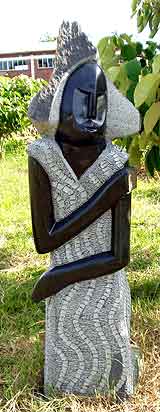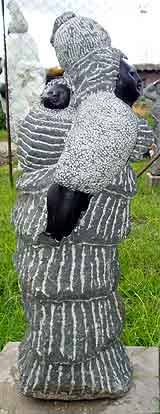|
|
Shona Sculptures (Africa, Zimbabwe)
Onasis Mutasa
History of the Shona Tribe and their Art
The Shona are the oldest tribe in Zimbabwe and are believed to be the legendary guardians of King Solomon's mines. The city of Great Zimbabwe is constructed with tight-fitting granite blocks without the use of mortar. The complex of ruins from which the modern nation of Zimbabwe took its name is derived from the Shona word "dzimba dza mabwe" meaning 'House of Stone'. The large stonewalls of this city were built for the King and also for defense. At the start of the 15th century, Great Zimbabwe had about 10-20,000 inhabitants and was at its cultural height. Each of the monoliths surrounding the city once bore a carved Zimbabwe bird, which symbolized power and it is now a famous Zimbabwean symbol often carved by the Shona people.
The Shona stone carvers are known as the "People of the Mist". Within the remote Inyanga Mountains an ethereal mist leads and guides them through their quest. Their religion is very spiritual and they believe in two kinds of spirits - Shave spirits and the Vadzimu spirits, which are considered to be ancestral spirits. The people also believe in good and bad spirits, the bad spirits have to do with witchcraft while the good spirits may inspire individual talents along with healing, music or artistic ability. They use witchcraft and traditional dances to summon the spirits of their ancestors. In Shona sculptures, the artist expresses the fundamental relationships between two guiding forces of Shona life, this being the visible physical world and the unseen spiritual world that exists in various cultures. The stone carvers believe that every rock contains a spirit essence that influences how the stone will be shaped and transformed during carving.
The stone sculptures produced by these artists display great individuality of form and content. Every piece is an original and is valued by the astute collector. The art is extremely seductive and amazingly beautiful with each stone containing rich colors and textures, which invite one to explore and touch visually, emotionally and intellectually. For the most part, Shona sculptors are self-taught and their artistic skill has impressed art collectors and dealers whenever they have been first exposed to it.
Shona sculptors use locally found stone and have become some of the most creative artists of our time. These stone sculptures are only found and carved in Zimbabwe, which continues to be the center for stone sculpture in Africa.

"Lonely Woman", by: Charles Nembaware
The Types of Stone used in Shona Sculptures
Introduction
From scintillating white granites to brilliant serpentines - reds, greens, maroons, grays, yellows, and vibrant oranges - the stone of Zimbabwe is a visual catalog of incredible mineral wealth. More than 250 specific ores and combinations of serpentine have been identified in Zimbabwe. It is the complex combination of these minerals that create the colorful palette so unique to Zimbabwean carving stone.
Artists use the locally found stone in Zimbabwe with the most common being Serpentine. Other stones include Opalstone, Verdite, Red Sandstone and Soapstone etc. Depending on the color, striations and contours of the stone, the artist during sculpting develops a relationship with the stone and depending on the form, carves a sculpture without sketches or drawings. Quintessentially, the stone dictates to the artist the subject that will emerge from within its core. The tools used are simply a hammer, chisel, file, water and sandpaper. Once the sculpture has been carved it is placed in a fire where the stone is heated. The final finishing stage is to apply a clear wax polish, which melts and absorbs into the stone, bringing out the stone's rich deep luster and color.
Opal stone/Lemon Opal stone
Opal stone is famous for it's milky light colored greens and smooth texture. It is also unique in that it has fewer color variations than Serpentine. It is also known as Opalite to the locals and is mined at Chiweshe, two hours north of Harare. This stone is one of the favorites of carvers, as it's not as hard as Spring stone and other serpentines, but still polishes to a high finish. Opal stone also has, at times, a brown color throughout the predominate green. The appearance can be smooth or mottled. As with most of the stones mined for the purpose of sculpting, opalite is mined without the use of power tools. Lemon Opal stone is easily identified by contrasting yellow striations within the stone. On the Mohs hardness scale, Opal stone rates between 5.0-5.5.
Serpentine / Black Serpentine / Fruit Serpentine
Serpentine is the next hardest stone with a rating of 4.0-5.0 on Mohs hardness scale. Black Iron Serpentine derives it's name from the deposits of iron found in it and is one of the hardest and darkest stones found in Zimbabwe. It has the most amazing black lustrous finish that resembles the black opal and is highly sought after because of its fine finish, durability and hardness.
Spring stone
Spring stone is one of the hardest stones used for sculpturing in Zimbabwe. There are a few mines, where this stone is found, but Guruve, in the north, is where spring stone is mined. A beautiful dark stone, it polishes to a high shine because of its density. A feature of this stone, is often, it will have a softer brown layer, which adds to the appeal. As with most other stones that are mined for the purpose of sculpturing, this stone is mined by hand on communal lands.
Verdite / Golden Verdite
Verdite has a unique Emerald looking quality with brown and green striations and is known as "Green Gold" because it is a semi-precious stone, which is unfortunately becoming rare and therefore increasingly more valuable. It is a hard stone and only the more experienced sculptor will dare to sculpt it. On the Mohs hardness scale Verdite rates between 7.0-9.0.
Stone type and its influence on the price of a sculpture
The value of a sculpture is determined firstly by the hardness of the stone chosen. The harder the stone, the more time it takes to carve and the more expensive it is to purchase. Thus, for example, the price of a piece of artwork in Verdite will be multiples of an equivalent piece in Soapstone. Please see the graphic below for a summary of the stone types.

"Mother & child going to Grinding Mill", by: Aaron Kapembeza
The types of wood used in Shona Sculptures
Ebony
This wood is famous for it's black lustrous beauty and artworks in this wood are highly sort after by collectors. It is a very dense wood with a dark interlocking grain and is normally brown on the outside of the tree and black on the inside. This is a tropical tree and can carry different fruits and flowers. The fruits of this tree are edible and some species produce milky latex that was used before natural rubber was discovered.
African Teak
African Teak is also known as 'Zimbabwean Teak' or 'Red Jarra' and is often described as an attractive reddish brown wood with irregular dark brown or black lines or flecks. It is a very heavy and hard wood, with a high resistance to abrasion. It is well known for it's bending and crushing strength, stability in service and decay resistance.
Mukwa
Mukwa is only found in Tanzania, Zambia, Mozambique, Zimbabwe and South Africa. It has variable colors such as a pale uniform brown, chocolate brown, brick red or purplish brown and golden brown. The texture is medium to coarse with a grain straight to interlock. When drying, it does not warp and has no tendency to split.
|
|


